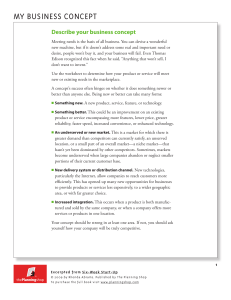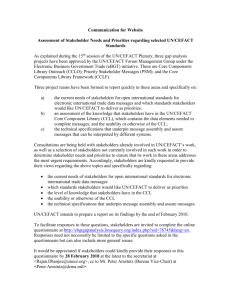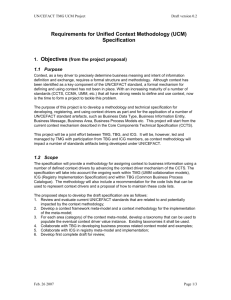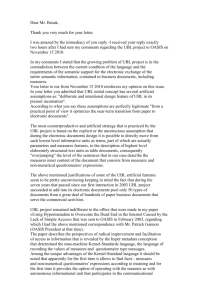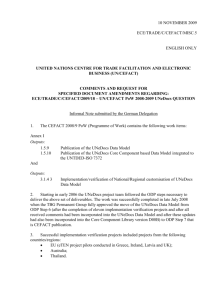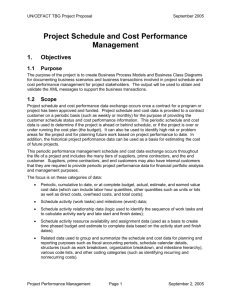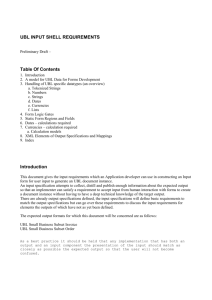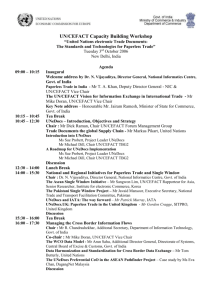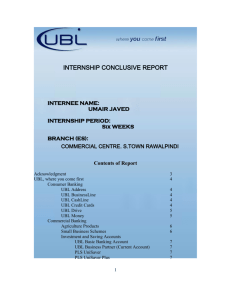e-Business Document Design and Customization Environment for
advertisement
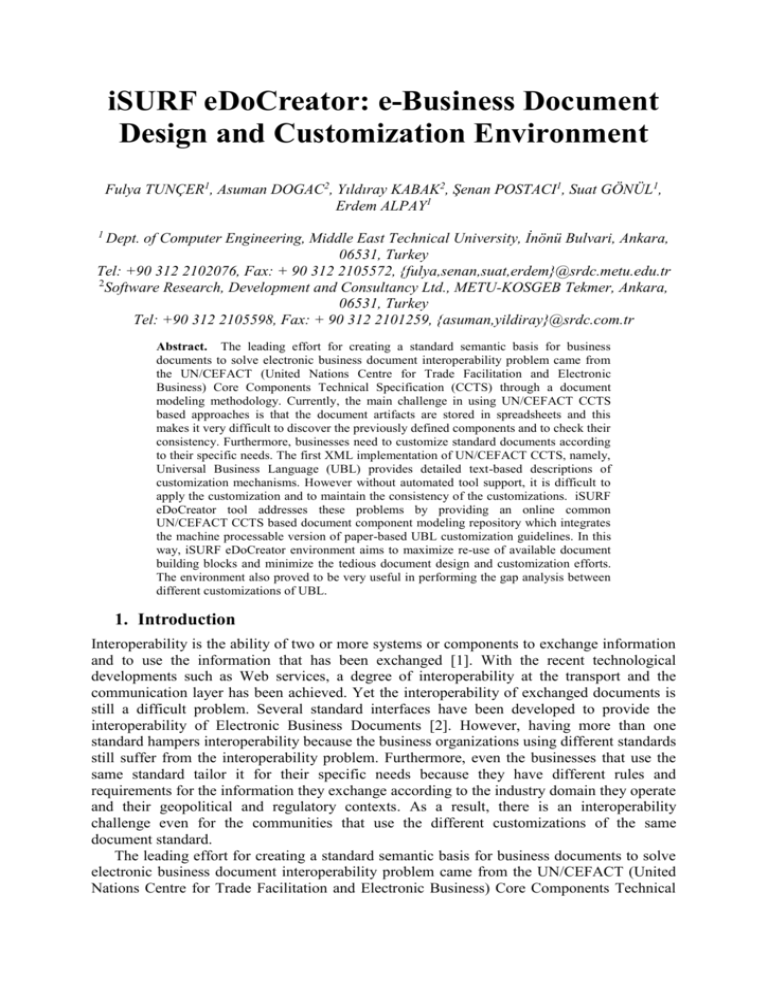
iSURF eDoCreator: e-Business Document
Design and Customization Environment
Fulya TUNÇER1, Asuman DOGAC2, Yıldıray KABAK2, Şenan POSTACI1, Suat GÖNÜL1,
Erdem ALPAY1
Dept. of Computer Engineering, Middle East Technical University, İnönü Bulvari, Ankara,
06531, Turkey
Tel: +90 312 2102076, Fax: + 90 312 2105572, {fulya,senan,suat,erdem}@srdc.metu.edu.tr
2
Software Research, Development and Consultancy Ltd., METU-KOSGEB Tekmer, Ankara,
06531, Turkey
Tel: +90 312 2105598, Fax: + 90 312 2101259, {asuman,yildiray}@srdc.com.tr
1
Abstract. The leading effort for creating a standard semantic basis for business
documents to solve electronic business document interoperability problem came from
the UN/CEFACT (United Nations Centre for Trade Facilitation and Electronic
Business) Core Components Technical Specification (CCTS) through a document
modeling methodology. Currently, the main challenge in using UN/CEFACT CCTS
based approaches is that the document artifacts are stored in spreadsheets and this
makes it very difficult to discover the previously defined components and to check their
consistency. Furthermore, businesses need to customize standard documents according
to their specific needs. The first XML implementation of UN/CEFACT CCTS, namely,
Universal Business Language (UBL) provides detailed text-based descriptions of
customization mechanisms. However without automated tool support, it is difficult to
apply the customization and to maintain the consistency of the customizations. iSURF
eDoCreator tool addresses these problems by providing an online common
UN/CEFACT CCTS based document component modeling repository which integrates
the machine processable version of paper-based UBL customization guidelines. In this
way, iSURF eDoCreator environment aims to maximize re-use of available document
building blocks and minimize the tedious document design and customization efforts.
The environment also proved to be very useful in performing the gap analysis between
different customizations of UBL.
1. Introduction
Interoperability is the ability of two or more systems or components to exchange information
and to use the information that has been exchanged [1]. With the recent technological
developments such as Web services, a degree of interoperability at the transport and the
communication layer has been achieved. Yet the interoperability of exchanged documents is
still a difficult problem. Several standard interfaces have been developed to provide the
interoperability of Electronic Business Documents [2]. However, having more than one
standard hampers interoperability because the business organizations using different standards
still suffer from the interoperability problem. Furthermore, even the businesses that use the
same standard tailor it for their specific needs because they have different rules and
requirements for the information they exchange according to the industry domain they operate
and their geopolitical and regulatory contexts. As a result, there is an interoperability
challenge even for the communities that use the different customizations of the same
document standard.
The leading effort for creating a standard semantic basis for business documents to solve
electronic business document interoperability problem came from the UN/CEFACT (United
Nations Centre for Trade Facilitation and Electronic Business) Core Components Technical
Specification (CCTS) [3] which provides a document modeling methodology. The ultimate
aim is to derive all electronic documents from common building blocks with well-defined
rules. This implies creating core document building blocks with common semantics and then
specializing them to the contexts. Additionally, both the core components and the specialized
document building blocks must be discoverable from a common repository to be able to reuse them. In other words, the well-defined semantics for the core document components
together with a discovery facility will improve their reusability and enhance interoperability.
The UN/CEFACT CCTS is syntax independent. One of its first syntax dependent
implementations in XML is UBL [4]. Currently, the approved version of UBL is 2.0 and there
are thirty one XML schemas for common business documents like “order” and “invoice”. In
addition to the document definitions, UBL 2.0 provides a library of XML schemas (XSDs) for
reusable common data components like “Address”, “Item", and “Payment" from which the
context specific documents are customized.
Currently the main challenge in using these UN/CEFACT CCTS based approaches like
UBL is the fact that the document artifacts are stored in spreadsheets and this makes it very
difficult, if not impossible, to discover the previously defined components and to check their
consistency. Furthermore, as already mentioned, businesses need to customize standard
documents according to their specific needs. The Universal Business Language (UBL)
provides detailed text-based descriptions of customization mechanisms. However without an
automated tool support, it is difficult to apply the customization and maintain the consistency
of the customizations.
iSURF eDoCreator addresses these problems by providing a document modeling
environment with a common online UN/CEFACT CCTS based component repository which
integrates the machine processable version of the paper-based UBL customization guidelines
to be applied on the document components. In this way, it aims to maximize the re-use of
available document building blocks and minimize the duplicative efforts of document
designers in customizing the document schemas.
The repository, available at [5], currently contains all of the BIEs in the common library
of UBL 2.0; all the BIEs of the UN/CEFACT Cross Industry Electronic Invoice (CII) [6]; all
the BIEs of NES [11] and UBLTR [12]. The repository is gradually evolving to include
document components from other standards such as the Core Components (CCs) and the
Business Information Entities (BIEs) of UN/CEFACT CCL 08B [13]. As the new document
models are created or document building blocks are customized and committed to the
repository, its impact on the data interoperability will increase by making it possible to share
all these with a wider audience.
2. Objectives
iSURF eDoCreator is a part of a larger effort, namely, iSURF Interoperability Service Utility.
The main objective of iSURF Interoperability Service Utility is to provide electronic business
document interoperability. For this purpose two parallel challenges are being addressed: One
is to semantically annotate the document schemas as described in [7] and the other is to
provide a graphical environment for the customization and re-use of UN/CEFACT CCTS
based document schemas, as described in this paper.
Creating, extending, customizing document schemas conforming to UN/CEFACT CCTS
methodology are tedious, labour intensive and time-consuming processes requiring (1)
analysis of available component interfaces (2) design of spreadsheet model of the document
(3) creation of XSD files and finally (4) creation of genericode files for each of the coded
attributes.
Although UN/CEFACT CCTS and UBL provide guidelines for document modeling and
document customization respectively, there is no machine processable process implemented
to help the designers. iSURF eDoCreator environment converts the UN/CEFACT CCTS
modeling methodology into a machine processable process to execute on the document
building blocks in the online repository and implements the UBL Customization guidelines to
provide common and publicly available document modeling services. The tool also generates
the spreadsheet model of the document schema and the XSD files along with the genericode
files.
3. Enabling Technologies and Standards
3.1 UN/CEFACT Core Component Technical Specification (CCTS)
UN/CEFACT Core Component Technical Specification (CCTS) provides a methodology for
semantic data modeling on a syntax independent level. It achieves a common understanding
of data structures and message types in order to provide interoperability at the data level
among e-Business applications. Furthermore, by setting Naming and Design Rules (NDR),
which define how to name, structure and assemble the components, it establishes a common
understanding among business partners eliminating ambiguities arising from
misinterpretations.
The key concepts of CCTS are based on Core Components (CC) and the Business
Information Entities (BIE): Core Components are building blocks with generic semantics and
purpose; they are context-neutral templates so that they can later be adapted to different
contexts and reused. Once the business contexts are declared on the CCs, they become BIEs
and reflect the requirements of a given business context based on that specific CC.
Both CCs and BIEs have three different types: Aggregated entities (ACCs and
ABIEs), which consist of one or more Basic entities (BCCs and BBIEs) as atomic attributes,
and Associated entities (ASCCs and ASBIEs) as complex attributes associating other
Aggreagate Entities. Furthermore, a Basic Entity is based on a Data Type which can be either
a Qualified Data Type or an Unqualified Data Type. All of these components are termed as
“document building blocks” in this paper.
3.2 OASIS Universal Business Language (UBL)
UBL is an OASIS standard which adopts the UN/CEFACT CCTS approach and defines a
library of XML schemas (XSDs) for re-usable components and common business documents.
Unlike to UN/CEFACT CCTS, it includes only Business Information Entities by excluding
Core Components. Furthermore, UBL 2.0 reuses Core Component Type and Data Type
definitions from UN/CEFACT CCTS.
There are two types of customizations specified in UBL 2.0 [8]: Conformant
customization and Compatible customization. The conformant customization allows the UBL
instances in the customized implementation to also conform to the original standard UBL 2.0
schemas.
UBL Conformant Customization Guidelines allow defining restrictions on the original
UBL schemas such as subsetting the document schema, defining constraints on document
content or applying custom codes. In conformant design guidelines only optional elements
may be excluded from the document schema. Furthermore, the cardinalities of the elements
can be updated with the following restrictions: minimum cardinalities can be increased up to
their maximum; maximum cardinalities can be decreased down to their minimum.
Compatible customization is used when conformant customization is not sufficient for
a specific implementation. For example, users may need to extend an ABIE, create a new
ABIE or create a new document from scratch. In compatible customization, the users modify
an existing UBL 2.0 schema or create a new one by re-using the largest suitable aggregation
from the UBL library. The key idea in UBL Compatible customization is to create new
entities based on UBL artifacts in order to preserve the common understanding.
4. iSURF eDoCreator System Architecture
The iSURF eDoCreator system architecture is composed of three main components as
shown in Figure 1.
Figure 1 iSURF eDoCreator System Architecture Components
The Graphical User Interface handles user interactions and helps to visualize
UN/CEFACT CCTS based conceptual model in a hierarchical tree view and converts
the conceptual model to logical model at the presentation layer. The tree view
specifies document building blocks with their type and the Dictionary Entry Names.
The tree icons identify type of the document building blocks, while the labels of the
tree nodes specify their Dictionary Entry Names. The hierarchical organization of
document components is shown through expandable tree interface. By clicking on the
nodes of the tree, users can expand a tree node and navigate over the tree structure to
see the composition details of document building blocks such as the Aggregate
Business Information Entities, Basic Business Information Entities or Association
Business Information Entities that are included in a Business Message Type, or the
Data Types of the Basic Business Information Entities. The user interface of the
modeling environment is implemented with Flex [9] since it provides Rich Internet
Application API enabling generation of user-friendly and highly-interactive Web
applications.
The Online Repository component provides persistency and graphical access to
the users over the Internet through its Web-based environment. The models generated
by the users are persisted by using a relational database and retrieved through
graphical queries. The wiki-based collaborative nature of the repository enables users
to participate in collaborations that it is accessible by other participants at the time of
submission.
The Guideline Processing Engine is the main controller of the modeling
environment. It guides the users in following the UN/CEFACT modeling and UBL
customization guidelines during the generation of standard-based but at the same time
customized business documents. The engine checks the consistency between user
actions and the guidelines at all steps. Furthermore, it handles interactions between the
graphical user interface and the repository and implements a number of key features of
the environment. The Persistency Engine mediates the interaction between user
interface and the persistency layer. It serializes document building block models into
an intermediate XML format in order to enable visualization of document building
blocks in graphical user interface and deserializes customized document building
block models into the intermediate XML format and then to the object model in order
to persist it into the repository. Moreover, it processes both Microsoft Excel or Open
Office Calc spreadsheets formats and loads document building blocks into the
repository. Query engine forms SQL queries according the keywords entered by users
and executes the query on the repository. Documentation Engine converts logical
models into physical model and generates XML Schema Definition (XSD) files
(XSD), spreadsheet models and genericode files in UBL directory format.
5. e-Business Document Design and Customization Environment
The iSURF eDoCreator tool provides online and 7/24 accessible environment for the
graphical modeling of business documents by integrating UN/CEFACT CCTS modeling and
UBL Customization guidelines. It is designed to aid the user in following these guidelines
during the generation of standard-based and customized business documents.
5.1. Providing the graphical view of the document building blocks in the repository and
querying the repository
Currently iSURF eDoCreator repository [5] contains all of the BIEs in the common library of
UBL 2.0; all the BIEs of the UN/CEFACT Cross Industry Electronic Invoice (CII) [6]; all the
BIEs of NES [11] and UBLTR [12]. The first functionality of the tool is to provide a
graphical view of the coarse-grained document building blocks such as Message Assembly,
Aggregate Business Information Entities, Basic Business Information and Qualified Data
Types in the repository as shown in Figure 2.
Figure 2 iSURF eDoCreator displaying the coarse-grained document building blocks in the repository
The tool provides the details of properties of these coarse-grained document building
blocks by clicking on the “properties” tab of the popup menu that appears when right clicking
on the selected item. This expandable view of the document building blocks allows the user to
see the whole data content of a component at a glance as shown in Figure 3. This is in contrast
to spreadsheet format in which rows corresponds to document building blocks, and columns
give the details of the component on that row. Furthermore, in the spreadsheet model, the
properties of an encapsulated data type are presented in separate spread sheets, so in order to
have a complete view of a document building block, it is necessary to explore more than one
spreadsheets.
Figure 3 Tree view of the selected BBIE
The retrieval of the document artifacts are realized through graphical queries. The
results list includes the standard document artifacts, the customized ones as well as the user
created document components. The keywords to form the queries are gathered from users via
a graphical interface. Furthermore, Boolean combinations of constraints can also be formed
by connecting the constraints using logical Boolean “AND” and “OR” connectors.
5.2. Creating a new document artifact
The second functionality of the iSURF eDoCreator tool is the support it provides to create
new document schemas by assembling available document building blocks by dragging and
dropping components into target message schema as shown in Figure 4. The tool
automatically locates the dragged component according to conventional ordering of
UN/CEFACT CCTS: Basic Business Information Entities are listed before Associations
Business Entities in the Message Assembly. Although the environment provides
UN/CEFACT CCTS methodology steps, it does not mandate a strict sequence in applying
these steps; rather it lets the users freely create the document models and guides them by
notifying and reminding the steps that needs to be taken.
Figure 4 Creating new document artifact
5.3. iSURF eDoCreator Support for Conformant and Compatible Customizations
The modeling environment supports both the UBL Conformant Customization and the
Compatible Customization. The customization starts by selecting a document artifact. It
allows (1) subsetting source document model, (2) extending source document model, (3)
constraining document artifacts and (4) creation of new document artifacts from scratch. In
case an action invalidating the Conformance Design Rules is taken by the user, the tool warns
the user that the design will not be conformant if the action is realized and lets the user
withdraw the action if he wishes.
Subsetting source document model is done through visualization of document building
block in a check tree. By selecting and deselecting tree nodes representing document building
blocks, users can subset the document model. Extending source document is done by dragging
and dropping available building blocks to assemble new building blocks. Constraining
document artifacts can be done via subsetting the document model, or refining a data type.
Creation of new document artifacts is described in Section 5.2.
5.4. iSURF eDoCreator Support for Refining a data type
A Data Type can be refined by modifying its content components or supplementary
components. The available built-in restriction types that can be defined on content
components vary according to type of the content component. For example, Text.Content can
be restricted by setting a value on its length, maximum length, and minimum length.
Supplementary components can be subsetted or their default/fixed or optional/required
attributes can be set. Users can either create a new Qualified Data Type from an Unqualified
Data Type or customize an existing Qualified Data Type to create a Qualified Data Type
tailored to their needs by refining a data type.
5.5. iSURF eDoCreator Support for Documentation of Document Model
The designed conceptual model of the document is converted to a physical model according
to the UBL Naming and Design Rules. The XML schema generator automatically detects
dependencies in BIEs and generates XSD files for both document schema and the common
artifacts. Furthermore, the tool generates spreadsheet models and genericode files in UBL
directory format.
6. Business Benefit and Conclusions
iSURF eDoCreator provides a document modeling environment for users to assemble their
documents from common components according to UN/CEFACT CCTS document modeling
methodology and customize these documents using UBL 2.0 customization methodology.
When the document building blocks are derived from a common semantic specification with
well-defined rules, it becomes possible to achieve electronic business document
interoperability.
iSURF eDoCreator tool has been used to derive the UBL 2.0 conformant eInvoice,
Turkey [12] from the standard UBL 2.0 eInvoice. Such customizations are becoming popular
recently, especially within the scope of the large scale integration project, PEPPOL (PanEuropean Public Procurement Online) [10] currently being implemented in EU. PEPPOL will
be producing UBL 2.0 conformant invoice, order, virtual company dossier and catalog
schemas to be customized to the Member States and we believe that the publicly accessible
iSURF eDoCreator tool provides an opportunity to help with these customizations.
Additionally, the tool proved to be very useful in performing the gap analysis between
NES/UBL Invoice [11] and eInvoice, Turkey [12].
Acknowledgements
The research leading to these results has received funding from the European
Community's Seventh Framework Programme (FP7/2007-2013) under grant agreement n°
213031, the iSURF Project.
References
[1] Institute of Electrical and Electronics Engineers. IEEE Standard Computer Dictionary: A Compilation of
IEEE Standard Computer Glossaries. New York (1990).
[2] Kabak Y., Dogac A., "A Survey and Analysis of Electronic Business Document Standards",
http://www.srdc.metu.edu.tr/webpage/publications, Submitted to ACM Computing Surveys.
[3] UN/CEFACT Core Components Technical Specification – Part 8 of the ebXML Framework in Version 2.01,
which is available at http://www.unece.org/cefact/ebxml/CCTS_V2-01_Final.pdf
[4] Universal Business Language (UBL) 2.0, http://www.oasis-open.org/committees/tc_home.php?
wg_abbrev=ubl
[5]
iSurf
eDoCreater:
e-Business
Document
Design
and
Customization
Environment.
http://www.srdc.com.tr/index.php?option=com_content&task=view&id=229&Itemid=203.
[6] UN/CEFACT Releases XML Schema for Cross Industry Electronic Invoice (CII).
[7] OASIS SET TC Deliverable: Semantic Representations of the UN/CEFACT CCTS-based Electronic
Business Document Artifacts (Editors: Dogac, Kabak), http://www.oasis-open.org/apps/org/workgroup/set/
[8] UBL Guidelines for Customization Version 1.0, 30 September 2008, http://xml.coverpages.org/ni2007-0404-a.html
[9] Adobe Flex, http://www.adobe.com/products/flex/
[10] PEPPOL (Pan-European Public Procurement Online), http://www.peppol.eu/
[11] NES. UBL Northern European Subset. http://www.nesubl.eu/
[12] OASIS UBL Turkish Localization Subcommittee, http://www.oasis-open.org/committees/sc_home.
php?wg_abbrev=ubl-trlsc
[13] UN/CEFACT Core Component Library, http://www.unece.org/cefact/codesfortrade/unccl/CCL08B.xls
